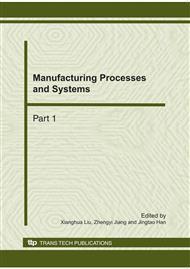p.783
p.788
p.794
p.799
p.803
p.808
p.812
p.818
p.822
Different Number of Shares and Twists Effect to the Sensing Performance of Conductive Yarns Contains Coated Carbon Fibers
Abstract:
This article designed 12 kinds of conductive yarns were fabricated by different number of shares and twists, observed the relationship of resistance and elongation through tensile test. It is shown that the resistance variation curve of conductive yarn generally approaches a parabola. That is, the resistance increased during the loading process; and the linearity of conductive yarns improved with the number of shares increased, but the sensitivity will decrease. Among the samples which contain the same number of shares but different twist per meter (TPM), samples were fabricated by 300TPM represented a better stability. Therefore, the textile sensors using conductive yarns could increase the number of shares or twists to improve the linearity in the situation that the sensitivity could achieve the minimum requirements.
Info:
Periodical:
Pages:
803-807
Citation:
Online since:
October 2010
Authors:
Keywords:
Price:
Сopyright:
© 2011 Trans Tech Publications Ltd. All Rights Reserved
Share:
Citation:


